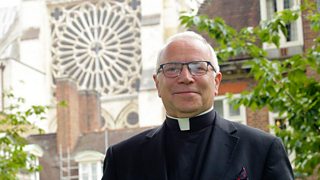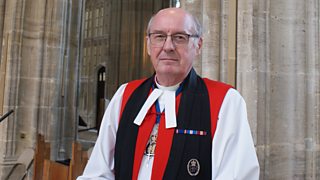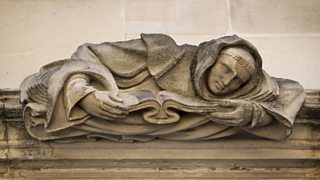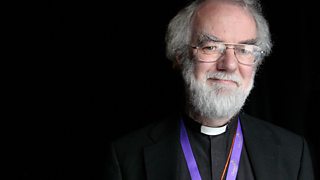The Sound of Holiness
Fr Marcus Holden leads a meditation on the holiness and beauty of God as reflected through Gregorian Chant and the sacred music of the Renaissance, with the Southwell Consort.
Leading British soprano and opera star Sophie Bevan MBE feels 'closer to God and the angels' singing simple Gregorian chant and the church music of the Renaissance than any other kind of music. As the Church approaches the season of All Saints, Fr Marcus Holden leads a meditation on the holiness and beauty of God as reflected through Gregorian Chant and the sacred music of the 15th and 16th century. The Southwell Consort, directed by Dominic Bevan and Will Dawes, specialise in music of this period. With Monsignor Philip Whitmore, Rector of St James' Spanish Place where the programme was recorded. Ave Maria (chant); O Worship the Lord in the Beauty of Holiness (Was Lebet); Isaiah 6:1-6; Veni Sancte Spiritus (chant); Revelation 5:11-14; O Nata Lux (Tallis); Jerusalem the Golden (Ewing); Media Vita (Sheppard). Producer: Philip Billson
Last on
More episodes
Previous
Clips
Soprano Sophie Bevan MBE writes...

For me, church music has been what nurtured my love for music and gave me the inspiration for a career and life centred around singing.����
I am the eldest of seven and as children, my parents sang the relevant Marian Antiphon to us every night in bed, my siblings joining in one by one as soon as they were able��–��cobbling together the Latin by ear. Then every weekend we were packed into the car and made the long journey from Somerset to Chelsea where my Father was director of music and where my mother sang soprano for the church of The Most Holy Redeemer and St Thomas More. We were again encouraged to join in and follow the music from a very young age. I’ll never forget the moment that I was quietly following along with my mum and she had to suddenly stop to attend to the baby and I carried on alone. When we finished a few bars later, everyone turned to me and exclaimed at my ability to hold the line for the first time! I was bursting with pride and it was the start of what has become one of the main joys of my life - singing polyphony on a Sunday morning.
As I grew older my confidence and that of my siblings grew and we were regularly picked by Dad for solos, all within the nurturing atmosphere of the organ loft at Holy Redeemer. Our voices matured and for a few of us, we came to the realisation that we were lucky enough to have been blessed with a gift that meant we could follow a vocational career using these gifts.
Now, at the age of 40 and singing all over the place in various opera houses and concert halls, the one place that I most love to sing is at church��–��St Birinus Church in Dorchester on Thames��–��where my husband the conductor and composer Ryan Wigglesworth and I run the music along with my sisters Daisy and Tess, and my cousins Francis and Dominic. It brings us back down to earth but on the other hand transcends all other music-making we do because we are doing it for love, not for money, and because the music is the most beautiful music of all to sing. Perhaps because that is where it all began for us. Simple Gregorian chant��–��the most ancient of all music and 15th- and 16th-century polyphony. I feel closer to God and the angels singing this music than any other!
The St Birnius Festival 2024
Sunday Worship Web Script
91�ȱ� Radio 4
The Sound of Holiness
Recorded at St James’ Church, Spanish Place,��London
��
Rector: Monsignor Philip Whitmore
Homilist: Fr Marcus Holden
Testimony: Sophie Bevan MBE
The Southwell Consort directed by Will Dawes and Dominic Bevan. The organist: Simon Lewis
Producer: Philip Billson
Opening announcement from Continuity: At ten past eight on 91�ȱ� Sounds and Radio 4 it's time for Sunday Worship which comes today from Marylebone in central London with the Southwell Consort. The service is introduced by the church's Rector Monsignor Philip Whitmore . The Sound of Holiness
��
Ave Maria����(plainchant) (0'34")
��
Monsignor Philip Whitmore:
Welcome to St James’s Spanish Place, in Marylebone London. This church has been a place of Catholic worship since the late 18th century, and nearby even from Reformation times, where the Spanish Embassy provided a location for the Mass when it was elsewhere forbidden.
��
Ave Maria�� (plainchant) (0'34")
��
Fr Marcus Holden leads our meditation.
Fr Marcus�� Holden: In worship we draw close to God from whom all beauty arises. The holiness in God is given to us in the coming of Jesus Christ into our world, in His loveliness�� we become beautiful by grace. Today we reflect upon the holiness and beauty of God and particularly upon its expression through music – the sound of holiness. As a priest, in my parish and in my ministry, I see how the holiness of God reaches people through architecture, art and especially music. There is something very wide and timeless about this – it reaches people from all ages and backgrounds. Our first hymn from John Monsell, one time chaplain to Queen Victoria and prolific poet, is very fitting to this holy place and for our theme of reflection today - O Worship the Lord in the Beauty of Holiness.��
��
O Worship the Lord in the Beauty of Holiness. (Was Lebet)��(3'44")
��
A reading from Isaiah Chapter 6 beginning at the first verse.����(vv1-6)
��
Fr Marcus – As with Isaiah the prophet the holiness of God is praised in the music of the angels in heaven and transmitted to us on earth, even in our unworthiness. From the earliest times of the Church, Christians have sung of the beauty of God. This tradition was inherited from the hymnbook of ancient Israel, the Psalms, where we are commanded, as in Psalm 68, Sing to God, sing praises to his name; lift up a song to him who rides through the deserts; his name is the LORD; exult before him! We know that Jesus Christ himself would have sung psalms (in the Temple and in prayer as in Matthew 26 where we read ‘And when they had sung a hymn, they went out to the Mount of Olives’). Drawn from this tradition and the sounds of other ancient cultures of converted Christians, distinct chants developed. Gregorian Chant is the name given to one of these earliest traditions. It’s named after Pope Gregory the Great who contributed massively to the development of worship in the West. Gregorian chant was sung, both to reflect the beauty of God, but also, to implore the outpouring of holiness and grace, the gift of the Holy Spirit. When the first missionaries sent by Pope Gregory arrived in England in 597AD just before Pentecost we’re told that they were chanting. This Gregorian hymn calling on the Holy Spirit reminds us of that tradition and also of the work of the Holy Spirit in bringing the life of heaven into our souls.����
��
Veni Sancte Spiritus��(chant) with speech over��(1'15" music clean)
��
Fr Marcus – Sacred Music has a long history and has helped countless people to draw close to the mystery of God through the centuries. But it remains a powerful channel of inspiration today. Sophie Bevan MBE takes principle parts in Opera Houses and concert halls here in the uk and across the world, but one of her particular loves is singing what is called the polyphonic, or multipart sacred music of the Renaissance. We’re privileged to have her singing in our choir this morning.����
��
Sophie Bevan MBE: Good morning. For me, church music has been what nurtured my love for music and gave me the inspiration for a career and life centred around singing. I am the eldest of 7 and as children, my parents sang the relevant Marian Antiphon to us every night in bed, my siblings joining in one by one as soon as they were able - cobbling together the Latin by ear. Then every weekend we were packed into the car and made the long journey from Somerset to Chelsea where my Father was director of music and where my mother sang soprano for the church of The Most Holy Redeemer and St Thomas More. We were again encouraged to join in and follow the music from a very young age. I’ll never forget the moment that I was quietly following along with my mum and she had to suddenly stop to attend to the baby and I carried on alone. When we finished a few bars later, everyone turned to me and exclaimed at my ability to hold the line for the first time! I was bursting with pride and it was the start of what has become one of the main joys of my life - singing polyphony on a Sunday morning. As I grew older my confidence and that of my siblings grew and we were regularly picked by Dad for solos, all within the nurturing atmosphere of the organ loft at Holy Redeemer. Our voices matured and for a few of us, we came to the realisation that we were lucky enough to have been blessed with a gift that meant we could follow a vocational career using these gifts. Now, at the age of 40 and singing all over the place in various opera houses and concert halls, the one place that I most love to sing is at church - St Birinus Church in Dorchester on Thames - where my husband the conductor and composer Ryan Wigglesworth and I run the music along with my sisters Daisy and Tess and my cousins Francis and Dominic. It brings us back down to earth but on the other hand transcends all other music making we do because we are doing it for love, not for money, and because the music is the most beautiful music of all to sing. Perhaps because that is where it all began for us. Simple Gregorian chant - the most ancient of all music and 15th and 16th century polyphony. I feel closer to God and the angels singing this music than any other!��
��
In Media Vita (John Sheppard) (Source: Christ Church Oxford MSS 979-983 (The 'Baldwin' Partbooks)) (0'59" clean music)
��
A reading from Revelation chapter 5 beginning at verse 11 -����(vv 11-14)
��
Fr Marcus – The full vision of God is opened to humanity by the death and resurrection of Jesus Christ. The book of Revelation describes with the best metaphors of the vision of John the sound and holiness of the worship of heaven.����Christian music through the ages preserved its original spiritual simplicity but also began to develop in multifaceted ways, to reflect the overwhelming richness of the vision of the holy. O Nata Lux is a piece by Thomas Talis who composed for the court of Queen Elizabeth I and for persecuted Catholics. It’s described as ‘polyphonic’ as it gives an overlapping of voices to mirror in a human cadence the sound of the angels. It was written for recusant Catholics during times of persecution and while there is sadness expressed, there is also the transformative vision of Jesus Christ, at his transfiguration, the ‘light born of light’ which enlightens us. We hear the supplication to receive holiness through becoming members of His body.����
��
O Nata Lux (Tallis)��(1'44")
��
Fr Marcus – In the Catholic writer J. R. R. Tolkien’s book Silmarillion, he speaks of the world being created through music. In this creation narrative of middle earth, God, who is called Iluvatar, expansive in�� loving, chooses to share divine life, ‘the flame imperishable’, by creating other music makers, who can both participate in the eternal music but also add new cadences. Some participate others do not, but for those who freely do, either immediately or subsequently in repentance, something beautiful arises. Creation and providence, in our world too, can be described in these terms. Such insights into the beautiful have shaped Christian understanding and worship. The need for music in praise has also been the backdrop for the development of broader culture – like a fruit of worship. The very language of music, musical notation, was developed in the monasteries. Guido of Arezzo is given the title of inventor of staff notation.�� The sound of chanting monks has accompanied the building of civilisations. The most fabulous edifices of medieval Christendom, the great Cathedrals and churches dotted throughout this land, arose, in one sense, from sacred music and for sacred music. From the earliest records of Christian faith we hear St Paul say, ‘be filled with the Spirit, addressing one another in psalms and hymns and spiritual songs, singing and making melody to the Lord with your heart’. When Pliny the Younger described the early Christians, their distinctive features that mark them out, he says ‘they sing songs to Christ as to a god’. It is not surprising that an Augustinian tradition states, ‘the one who sings, prays twice’.����
��
Veni Sancte Spiritus (chant) (2'04")
��
We believe that God is transcendent and beyond our reach and yet all which comes forth from God reflects in some way the truth of His eternal being. God is therefore all good and beautiful. This is the holiness of God of which the Scriptures speak. The startling claim of Christianity is that in Christ the goodness and beauty of God, the holiness of eternity, become present and accessible to us. The whole of Christian life and worship can be described as drawing close to this holiness and being transformed by it. The call to be ‘holy as I am holy’ is the call to be ‘good and beautiful as I am good and beautiful’. This revelation of holiness, in goodness and beauty, is supremely attractive. St Augustine of Hippo, reflected upon his famous conversion, writing, ‘Late have I loved you, Beauty so ancient and so new, late have I loved you!...You called, shouted, broke through my deafness; you flared, blazed, banished my blindness; you lavished your fragrance, I gasped; and now I pant for you; I tasted you, and now I hunger and thirst; you touched me, and I burned for your peace’. Ultimately, we only receive a full measure of this beauty in heaven, and that is why Christians often sing of heaven and see themselves as pilgrims on a journey there. We approach the celebration of All Saints at this time in the year, and we’re reminded that they receive holiness from Christ, all that lights their souls comes from His light. The saints participate in that great song of the heavenly Jerusalem.��
��
Next verses of O Nata Lux����(Pre sole vultu flammeus) (1'37")
��
Fr Marcus - The great British hymn tradition is one of the treasures of these isles. It‘s shared by many Christian churches and communions. The tradition is a development of chant using metrical musical patterns. The use of organs enables whole congregations to sing in unison. The tones are often drawn from chant and, as in the hymn to follow Jerusalem the Golden, the words come from ancient motets and poems. Bernard of Cluny writes this poem about heaven in which we participate on earth through our worship. It comes from his De Contemptu Mundi (On the Contempt of the World) not a motif of despising the creation, but about not allowing what is worldly to prevent access to the heaven for which we were made. Its English version is by the Anglican John Mason Neale. ‘There is the throne of David; and there, from care released, the shout of those who triumph, the song of those who feast; and they, who with their Leader have conquered in the fight, forever and forever are clad in robes of white’.��
��
Jerusalem the Golden��(Ewing) (2'45")
��
Our Father, who art in heaven, hallowed be thy name. Thy kingdom come, thy will be done on earth as it is in heaven. Give us this day our daily bread, and forgive us our trespasses, as we forgive those who trespass against us, and lead us not into temptation, but deliver us from evil. Amen��
��
Fr Marcus – The Southwell consort specialises in the tradition of English polyphony. Next weekend they appear at the second annual St Birinus Festival�� (of music within the context of Catholic liturgy) - in Dorchester on Thames. This next piece, the Media Vita, which you will hear as we make today our intercessions and prayers, was written by John Sheppard. Born in 1515 and died probably of flu in 1558 he lived through some of the most tumultuous religious times in our country’s history. He suffered and yet he keeps producing the music of holiness. This piece comes at the high point of this great tradition, and it speaks of the struggles of life but also of the Holiness of God, from which we gain strength. ‘Holy God, Holy mighty, Holy and merciful Saviour’. In the ancient Ambrosian rite these words were used for the litany of the saints on All Saints’ Day. It reminds us to keep focussed on the beauty of heaven even in the midst of trials.��
��
In Media Vita (John Sheppard) (Source: Christ Church Oxford MSS 979-983 (The 'Baldwin' Partbooks)) (2'00" clean music)
��
Intercessions –
��
Approaching the thrice Holy God, the holiest in the heights, we bring the needs of the Church and of the World.��
��
As we approach the great feast of All Saints, we pray for a new outpouring of holiness in our day, so that new saints may arise. Lord hear us, Lord graciously hear us.�� (response from a smaller group)����
��
We pray for all people throughout the world searching for real goodness and lasting light, that they may find what they seek in their faith. Lord in your mercy, hear our prayer. (response from a smaller group)��
��
We pray for all those who offer their natural gifts and inspired talents to the beautifying of the church on earth and her worship. We pray especially for blessings on all musicians and those who sing to give true praise to the Lord. Lord in your mercy, hear our prayer. (response from a smaller group)��
��
At this time of war and conflict in the Holy Land and Middle East, Sudan, Ukraine and in and so many places of conflict not in the news, we pray for justice and for peace. Lord hear us, Lord graciously hear us.�� (response from a smaller group)����
��
We remember those who have died, and those whose anniversaries occur about this time, and we pray that they may rest in the glory and joy of heaven. Lord hear us, Lord graciously hear us.�� (response from a smaller group)����
��
The Blessed Virgin Mary magnifies the beauty of divine grace, we continue to call her blessed and ask her intercession before the Lord. (small group) Hail Mary, full of Grace, the Lord is with thee. Blessed art thou amongst women, and blessed is the fruit of thy womb, Jesus. Holy Mary, mother of God, pray for us sinners, now and at the hour of our death. Amen.����
��
In Media Vita
��
Closing announcement from Continuity: In Media Vita by the 16th century English Gentleman of the Chapel Royal John Sheppard. And you can hear a full length version of that anthem on today's Sunday Worship webpage where you can also find details of the St Birinus Festival where the Southwell Consort will be singing next weekend. Sunday Worship came from St James Church Spanish Place and was led by Father Marcus Holden. The music directors were Will Dawes and Dominic Bevan, the organist was Simon Lewis and the producer Philip Billson. Next week Sunday Worship marks All Souls Day with a visit to the rather ghostly medieval ruins of Byland Abbey in North Yorkshire. That's at the usual time of ten past eight here on 91�ȱ� Radio 4.��
Broadcast
- Sun 27 Oct 2024 08:1091�ȱ� Radio 4











